During your safari in Tanzania we drive you through the African Savannah where trees and grasses are the food for the wild animals. The trees are dispersed and there is not a closed canopy.
The African Baobab Tree – Adansonia digitata
Baobab is one of the most common trees during the safari. This tree is native to the African continent and is also found in Tanzania Savannah. Some believe that this tree was planted upside down because of its appearance. Some African tribes believe that baobabs were upright and too proud. The gods became angry and uprooted them and threw them back into the ground upside-down.

The tree reaches height of 5–25 m (16–82 ft), and its trunk reaches a diameter of 10–14 m (33–46 ft). The roots actually exceed the tree height which help it to survive dry climate. The tree life span is over 1000 years.
Whistling Thorns – Vachellia drepanolobium/Acacia drepanolobium
Acacia drepanolobium is a species of plants in the family Fabaceae. It fixes nitrogen. It is a photoautotroph, is a slender shrub or a tree, with short branches radiating from the main stem. Usually growing 1 – 5 meters tall and occasionally reaching 8 meters.
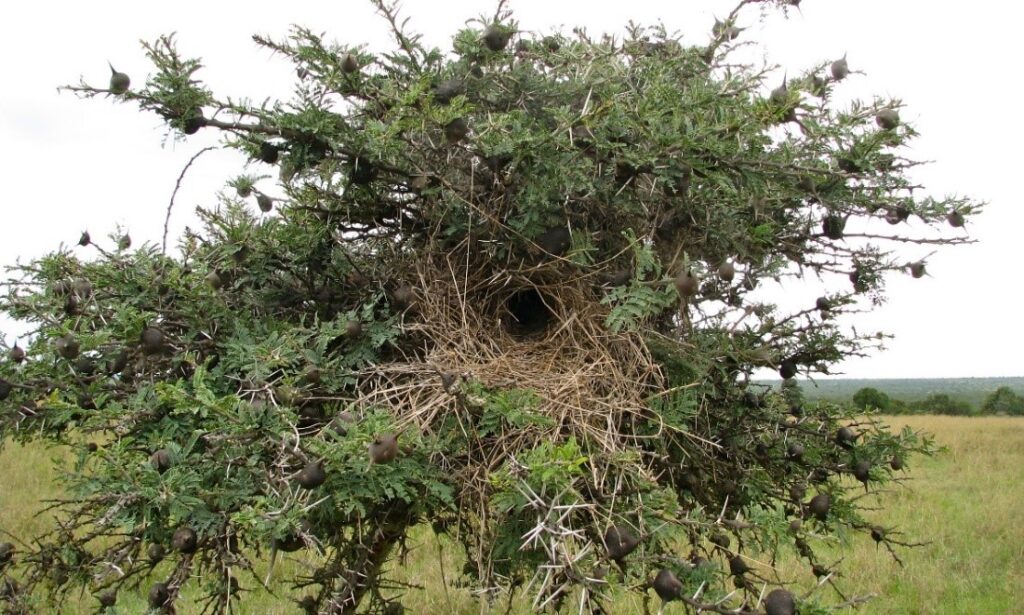
The common name of the plant comes from the observation that when the wind blows over bulbous spines in which ants have made entry/exit holes, they create a whistling noise. The tree actually encourages these ants by both providing homes and food in special flower-like structures called “extra-floral nectaries”.
Sausage Tree – Kigelia africana
The sausage tree of sub-Saharan Africa is beautiful in flower, the blood-red to maroon flowers hang in long panicles. The fragrance of the flower is not pleasing to humans but attracts the Dwarf Epauletted Fruit bat (Micropteropus pusillus), its pollinator.
This tree can reach a height of as much as 20 meters. The tree grows in the tropical and wet Savannah regions of sub-Saharan Africa.

The large tree is spread sparsely throughout Serengeti. It produces characteristic long (up to 1 m), succulent, poisonous fruits that drop from the tree and release seeds as the pulp rots. There are different uses of this tree fruit including: manufacturing number of skin care products and also making alcoholic beverage etc.
Acacia Tree
Acacia trees are without a doubt the most iconic trees in Africa. You can spot this tree within most of the Savannah area throughout the continent, most acacia usually lives only 20 to 30 years. Their long roots help stabilize the soil in areas threatened by erosion. The sturdy roots reach deep for underground water, which explains why the tree tolerates extreme drought conditions.
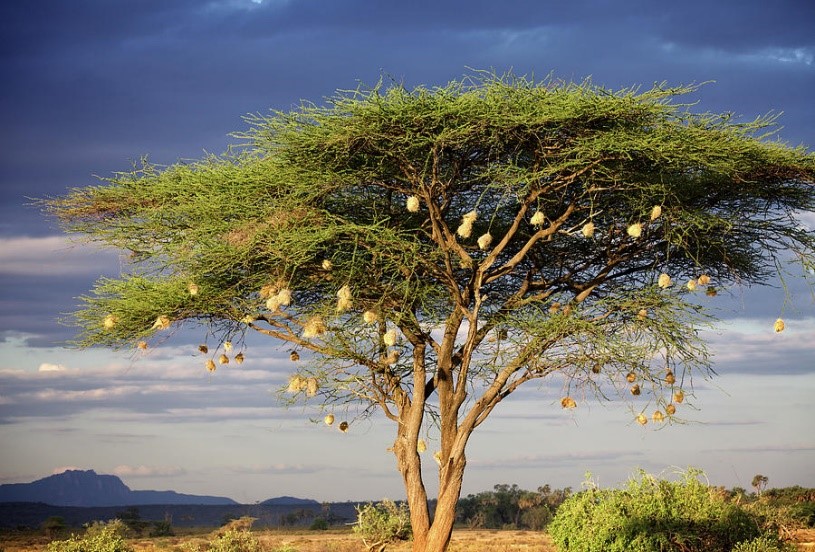
Another name for acacia tree is thorn trees. Some have long straight thorns while others have hook-shaped ones. The main reason is that it acts as a deterrent against browsers. Scientists have said that despite the thorns, some herbivores still feed on the trees, the thorn does not prevent feeding, but limits over-grazing.
Strangler Fig – Ficus thonningii
Strangler fig is one of the most common hemiepiphyte. Is the towering strangler fig tree which starts life as a tiny seed in the canopy named for their pattern of growth upon host trees. This results in the host’s death so that the strangler fig becomes a “columnar tree” with a hollow central core, the tree can grow 6 – 21 meters tall.
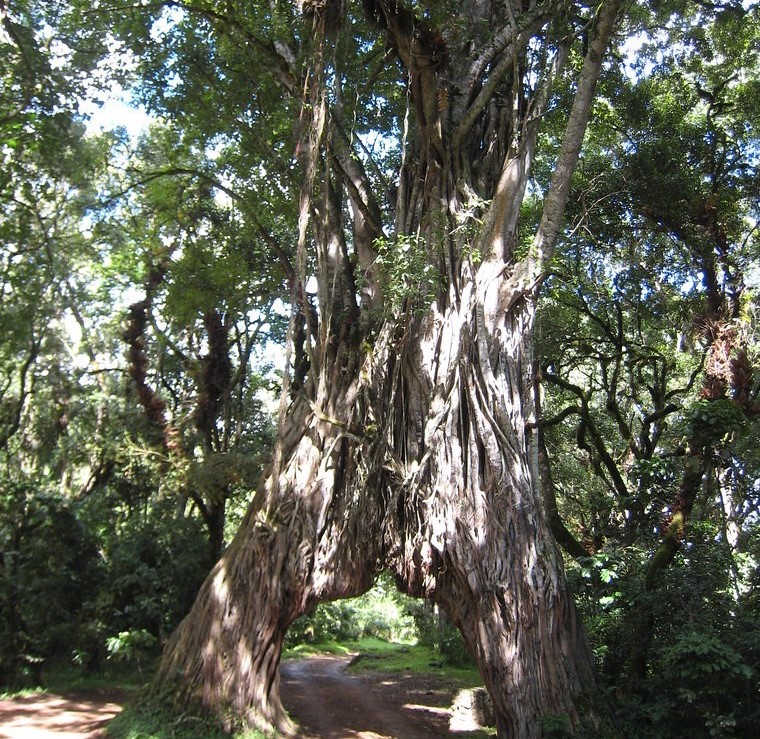
Strangler figs are ecologically important in some tropical forests. The hollow centers of strangler figs are full of spaces that provide shelter and breeding sites for bats, birds, and other animals. Perhaps more importantly, many stranglers are considered “keystone species” in that they provide food to a wide variety of animals during times of scarcity.
This tree is native in Africa, specifically Tanzania where is common in kopjes and along rivers in Serengeti. Also the tree is significant to the native people in cultural and medical aspect where they use in treating colds, sore throat, dysentery, wounds, constipation, nosebleed and to stimulate lactation.
Wild Date Palm – Phoenix reclinata
Phoenix reclinata is growing in a range of habitats, often seasonally water-log, such as along watercourses in high rainfall areas, in riverine forest and even in rainforest areas. Phoenix reclinata can reach up to 12 m but is most often between 3 and 6 m. It may be either single or multi-stemmed, sometimes forming a dense, bushy clump.
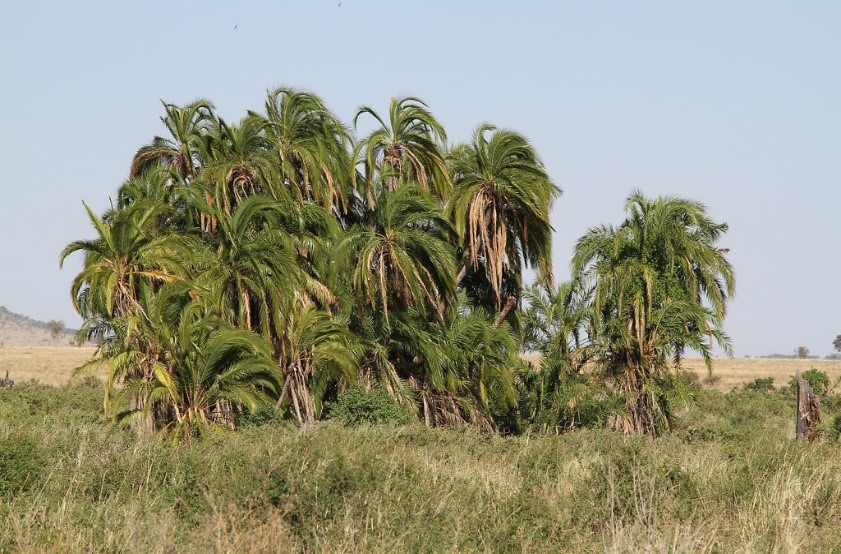
Flowers and fruits: fruits are up to 1-2.5 cm long, ovoid and reddish-brown to scarlet when ripe. The fruits are edible, though horrible tasting, while the thick, sugary sap is made into palm wine.
Toothbrush Tree – Salvadora persica
Salvadora persica L, also known as Arak (in Arabic) and Peelu (in Urdu), is the most common traditional source of tooth or chewing stick (miswak). To date, extensive studies have probed primarily into the validation of its traditional uses in oral care, is an evergreen shrub, with a short trunk 4–6 m tall, smooth green leaves and white bark.
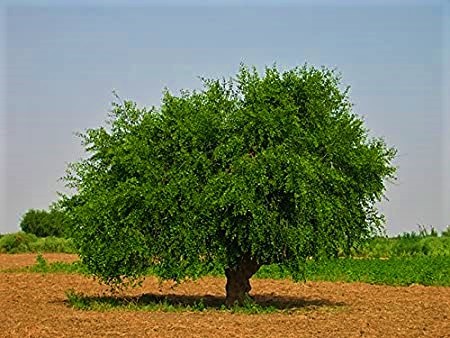
The fresh leaves are sometimes useful as salad and are also useful in traditional medicine for cough, asthma, scurvy, rheumatism, piles, and other diseases. The plant is native to the Middle East and Africa you can spot them on desert floodplains, riverbanks, and grassy savannah.
Euphorbia Candelabra – Euphorbia candelabrum
This is one the most common tree during the safari, Euphorbia candelabrum is a succulent tree with branches that are persistent from around 3 metres upwards, almost erect, rebranching to form a large, broadly rounded crown. The tree usually grows up to 12 meters tall, though specimens up to 20 meters have been recorded.
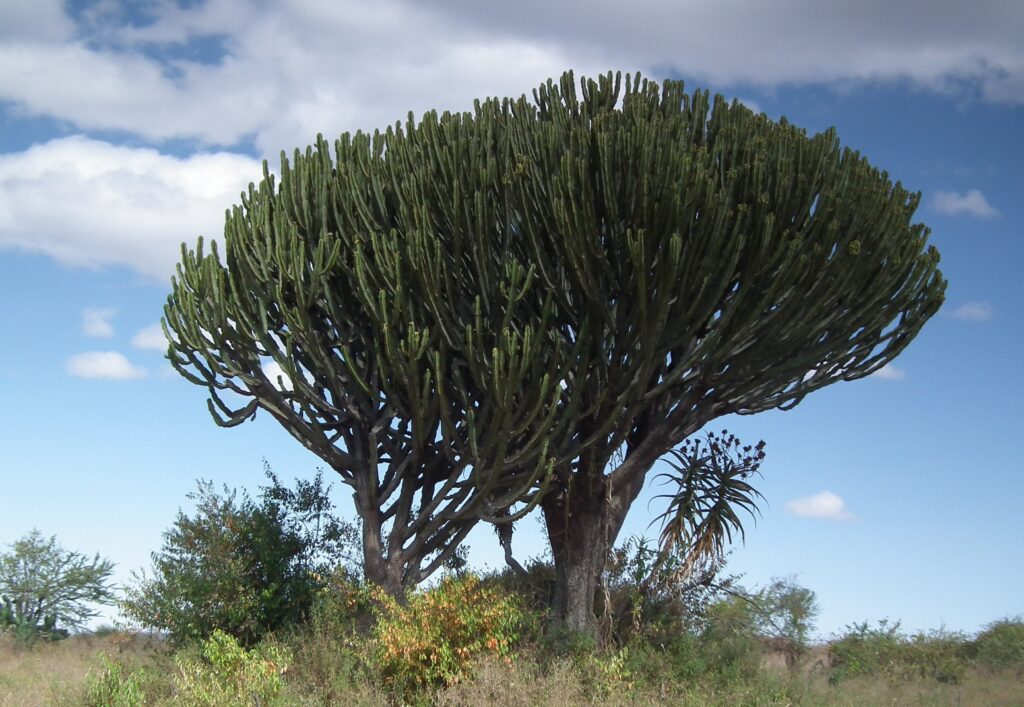
It’s one of the more poisonous spurges. The tree releases an abundant amount of milky-white latex which is very bitter and acrid contains diterpenes and is consider as highly toxic due to its skin irritant and carcinogenic.
Umbrella Thorn Acacia – Acacia tortilis
The bark has a rough feel and is grey to black in color. The tree has a combination of one straight thorn with a small hooked thorn alongside. The thorns are thin and grow in pairs. The flowers form in clusters of old wood. The flowers themselves are creamy, white, balls. The pods are a distinctive pale, gold brown color and are curled and twisted. The leaves are very small giving the umbrella a soft, feathery appearance.
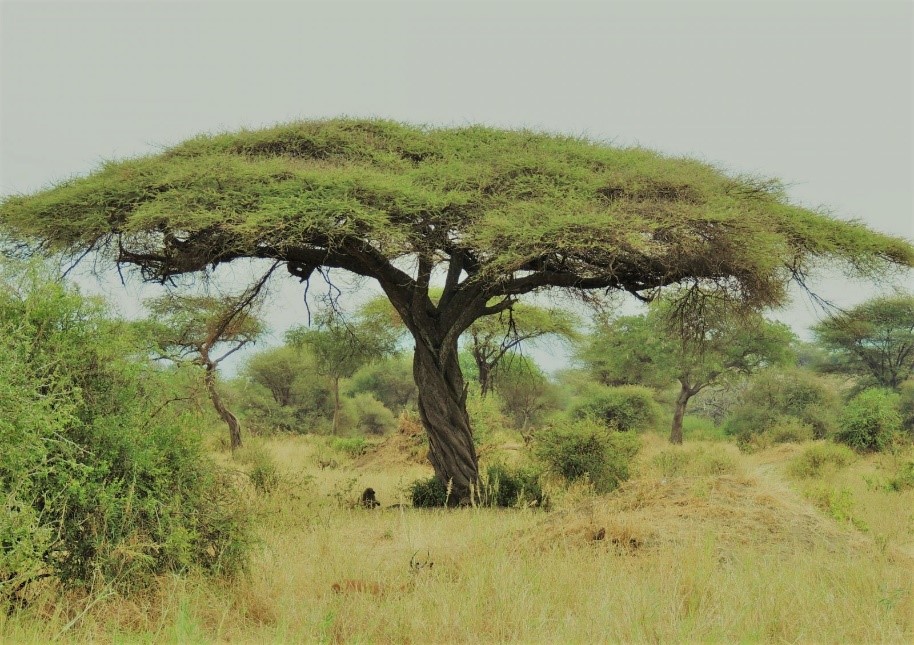
In extremely arid conditions, it may occur as a small, wiry bush. It grows up to 21 m (69 ft) in height. The tree carries leaves that grow approximately. 2.5 cm (1 in) in length with between 4 and 10 pairs of pinnae, each with up to 15 pairs of leaflets. Flowers are small and white, highly aromatic, and occur in tight clusters. Seeds are produced in pods which are flat and coiled into a springlike structure.
Yellow Fever Tree – Acacia xanthophloea
The yellow fever Tree is a low elevation medium to tall tree growing along or in water. The beauty of this tree comes from the clusters of 10 yellow ball flowers. Pieces of the magnificent, smooth, greenish-yellow bark flake off as the tree matures, giving an interesting, colorful pattern to the trunk. Leaflets are 2.5–6.5 mm × 0.75–1.75 mm. Petiolar glands are usually present at the base of the upper pinnae pairs. Spines are white, straight and strong and arranged in pairs.
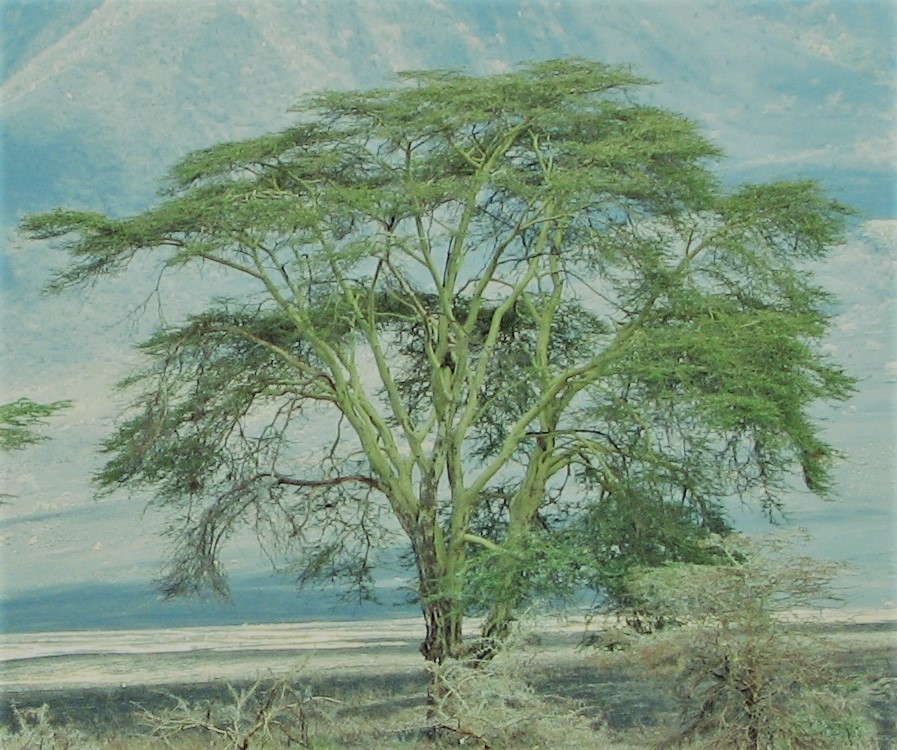
The common name comes from the misunderstanding of early settlers who thought the tree was the carrier of the malaria fever. Because the tree grew in swamp areas conducive to malaria mosquitos, people associated the fever with the tree.
Contact our office to book your safari in Tanzania: info@savannahexplorers.com – WhatsApp +255765972458





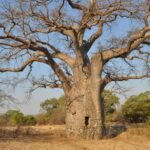
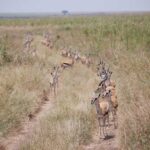

The information is understandable,much appreciated